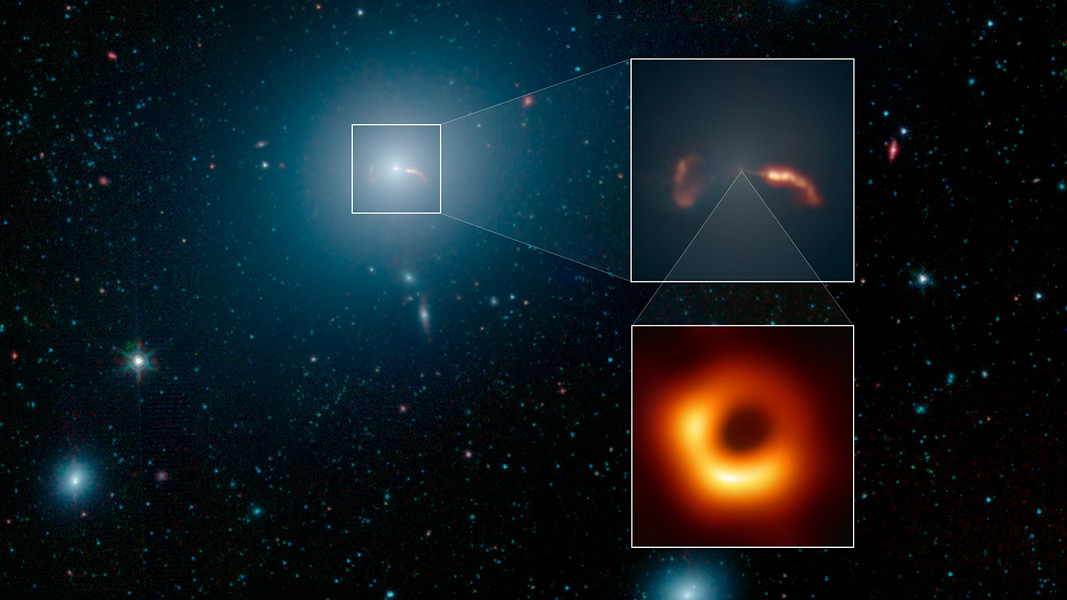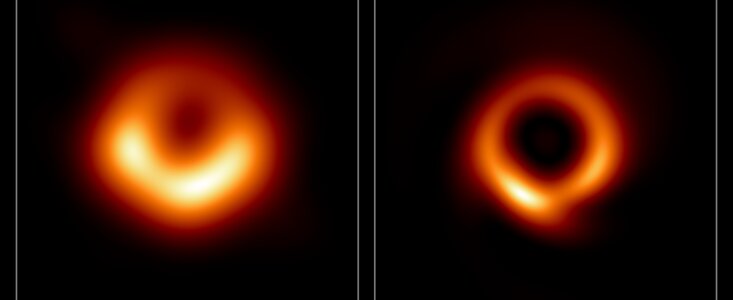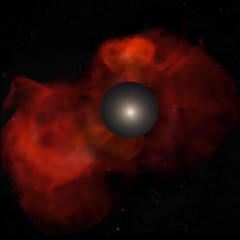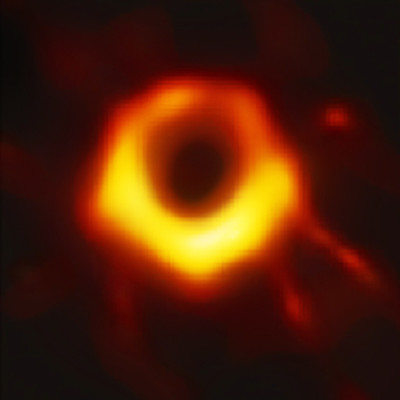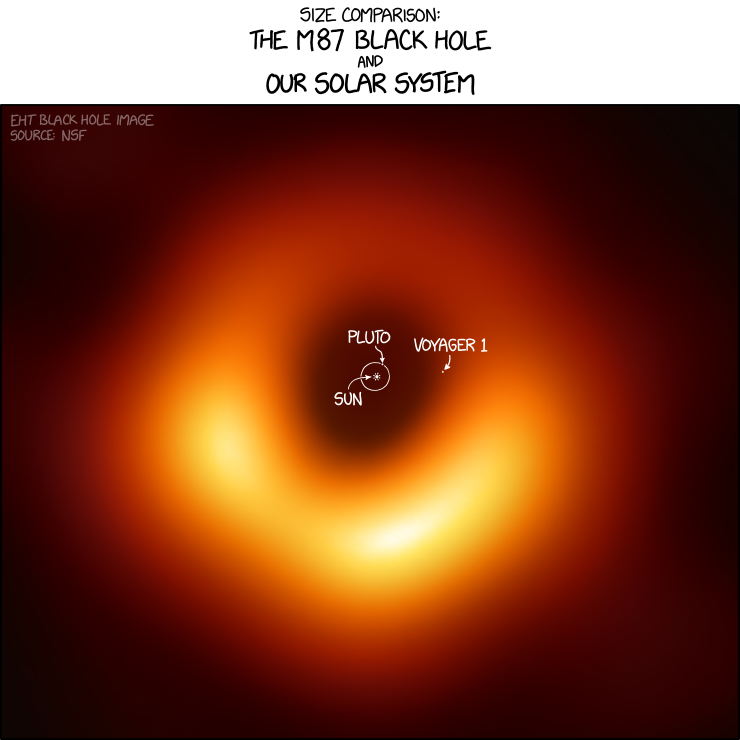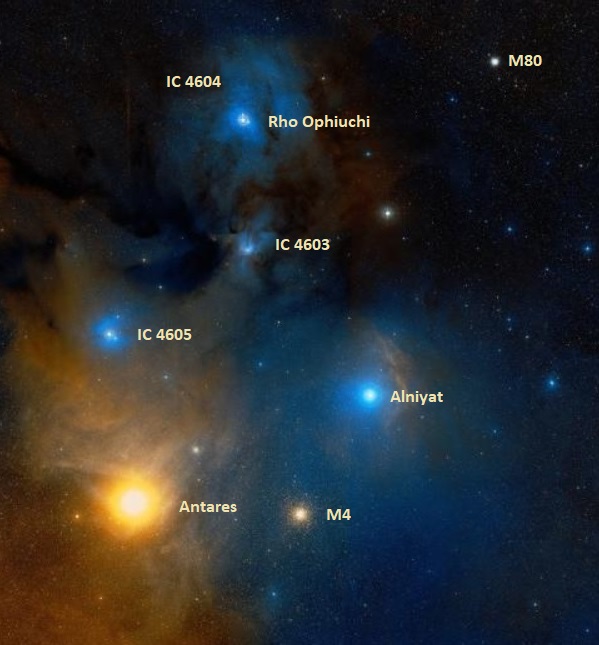Page 1 of 2
APOD: The Galaxy, the Jet, and a Famous... (2023 May 04)
Posted: Thu May 04, 2023 4:08 am
by APOD Robot
 The Galaxy, the Jet, and a Famous Black Hole
Explanation: Bright elliptical galaxy Messier 87 (M87)
The Galaxy, the Jet, and a Famous Black Hole
Explanation: Bright elliptical galaxy Messier 87 (M87) is home to the supermassive black hole captured in 2017 by planet Earth's
Event Horizon Telescope in the first ever image of a black hole. Giant of the Virgo galaxy cluster about 55 million light-years away, M87 is the large galaxy rendered in blue hues in this infrared
image from the Spitzer Space telescope. Though M87 appears mostly featureless and cloud-like, the Spitzer image does record details of relativistic jets blasting from the galaxy's central region. Shown in the inset at top right, the jets themselves span thousands of light-years.
The brighter jet seen on the right is approaching and close to our line of sight. Opposite, the shock created by the otherwise unseen receding jet lights up a fainter arc of material. Inset at bottom right, the
historic black hole image is shown in context, at the center of giant galaxy and relativistic jets. Completely unresolved in the Spitzer image, the
supermassive black hole surrounded by infalling material is the source of enormous energy driving
the relativistic jets from the center of active galaxy M87. The Event Horizon Telescope image of M87 has now been enhanced to reveal a
sharper view of the famous supermassive black hole.
Re: APOD: The Galaxy, the Jet, and a Famous... (2023 May 04)
Posted: Thu May 04, 2023 5:28 am
by Ann
It's kind of funny that
I posted the picture that is today's APOD in one of my replies to shaileshs just yesterday!

As a color commentator, I have to comment on the colors of the APOD. M87 itself looks very blue, as do the two other Virgo cluster galaxies visible in the image (at bottom and bottom left). The reason for the blue color is that in infrared Spitzer images, starlight is shown as blue and dust as red. This means that M87 and the two other Virgo galaxies lack dust clouds - except, mind you, in the red-tinted shock waves caused by the jets of M87! They are dusty!

But please note that while the picture of the Virgo galaxies and the shock waves caused by the M87 jets is an infrared image by the Spitzer Space Telescope, colored according to "Spitzer image standards", the black hole picture inset is a radio image. The black hole may be dusty, or not - probably not!!! - but in any case, the red-orange color of the bright ring of the black hole does not represent the same thing as the red color of the shock waves caused by the M87 jets seen in the Spitzer image.
What I found most interesting about today's APOD was the last link, which takes us to the new, improved image of the black hole of M87:
NOIRLab wrote:
The iconic image of the supermassive black hole at the center of Messier 87 has received its first official makeover, thanks to a new machine-learning technique known as PRIMO. This new image better illustrates the full extent of the object’s dark central region and the surprisingly narrow outer ring. To achieve this result, a team of researchers used the original 2017 data obtained by the Event Horizon Telescope (EHT) collaboration and created a new image that, for the first time, represents the full resolution of the EHT.
...
In 2017 the EHT collaboration used a network of seven radio telescopes at different locations around the world to form an Earth-sized virtual telescope with the power and resolution capable of observing the “shadow” of a black hole’s event horizon. [2] Though this technique allowed astronomers to see remarkably fine details, it lacked the collecting power of an actual Earth-sized telescope, leaving gaps in the data. The researchers’ new machine-learning technique helped fill in those gaps.
“With our new machine-learning technique, PRIMO, we were able to achieve the maximum resolution of the current array,” said lead author Lia Medeiros. “Since we cannot study black holes up close, the detail in an image plays a critical role in our ability to understand its behavior. The width of the ring in the image is now smaller by about a factor of two, which will be a powerful constraint for our theoretical models and tests of gravity.” ...
The team confirmed that the newly rendered image is consistent with the EHT data and with theoretical expectations, including the bright ring of emission expected to be produced by hot gas falling into the black hole.
Ann
Re: APOD: The Galaxy, the Jet, and a Famous... (2023 May 04)
Posted: Thu May 04, 2023 5:33 am
by alter-ego
I like the new M87 radio (3.5 mm) image which includes the BH and the connected jets. Bystander
posted about this new radio imaging, but I wanted to mention it again in this APOD.
In the S&T article (Camille Carlisle), there are several links in addition to the Nature paper:
A ring-like accretion structure in M87 connecting its black hole and jet
Re: APOD: The Galaxy, the Jet, and a Famous... (2023 May 04)
Posted: Thu May 04, 2023 10:38 am
by AVAO
Ann wrote: ↑Thu May 04, 2023 5:28 am
It's kind of funny that
I posted the picture that is today's APOD in one of my replies to shaileshs just yesterday!
...
What I found most interesting about today's APOD was the last link, which takes us to the new, improved image of the black hole of M87:
NOIRLab wrote:
The iconic image of the supermassive black hole at the center of Messier 87 has received its first official makeover, thanks to a new machine-learning technique known as PRIMO. This new image better illustrates the full extent of the object’s dark central region and the surprisingly narrow outer ring. To achieve this result, a team of researchers used the original 2017 data obtained by the Event Horizon Telescope (EHT) collaboration and created a new image that, for the first time, represents the full resolution of the EHT.
...
In 2017 the EHT collaboration used a network of seven radio telescopes at different locations around the world to form an Earth-sized virtual telescope with the power and resolution capable of observing the “shadow” of a black hole’s event horizon. [2] Though this technique allowed astronomers to see remarkably fine details, it lacked the collecting power of an actual Earth-sized telescope, leaving gaps in the data. The researchers’ new machine-learning technique helped fill in those gaps.
“With our new machine-learning technique, PRIMO, we were able to achieve the maximum resolution of the current array,” said lead author Lia Medeiros. “Since we cannot study black holes up close, the detail in an image plays a critical role in our ability to understand its behavior. The width of the ring in the image is now smaller by about a factor of two, which will be a powerful constraint for our theoretical models and tests of gravity.” ...
The team confirmed that the newly rendered image is consistent with the EHT data and with theoretical expectations, including the bright ring of emission expected to be produced by hot gas falling into the black hole.
Ann
ThanX Ann for your exciting explanations yesterday and today!
I'm not so sure if AI is best able to depict reality everywhere, even if the images suddenly seem much sharper. For example the BH in M87: Last year I compared and superimposed all the variants developed by the various research teams for interpretation. You can see the result below. It's a BH donut with four outflows. Two of the outflows are very close together. The latest pictures (bystander post) show three outflows, whereby the middle one can also be interpreted as two smaller outflows, which intertwine. My own interpretation of the image from last year fits in pretty well. I am sure that the upcoming images from JWST will show this even more clearly.
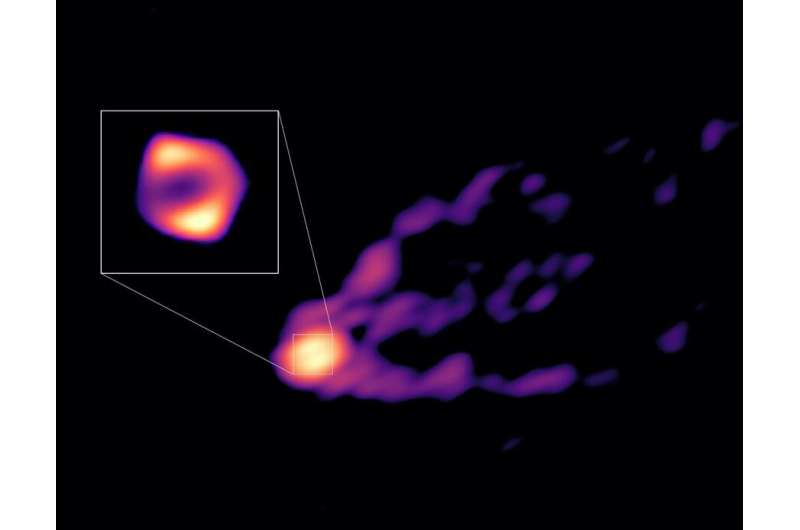
Another interesting detail of the SPITZER picture is the hidden "smoke" ring (blue channel) on the left. I'm pretty sure this isn't an imaging error and it will turn out that it wasn't accidental. Let's see when the next papers will appear on arxiv to that topic

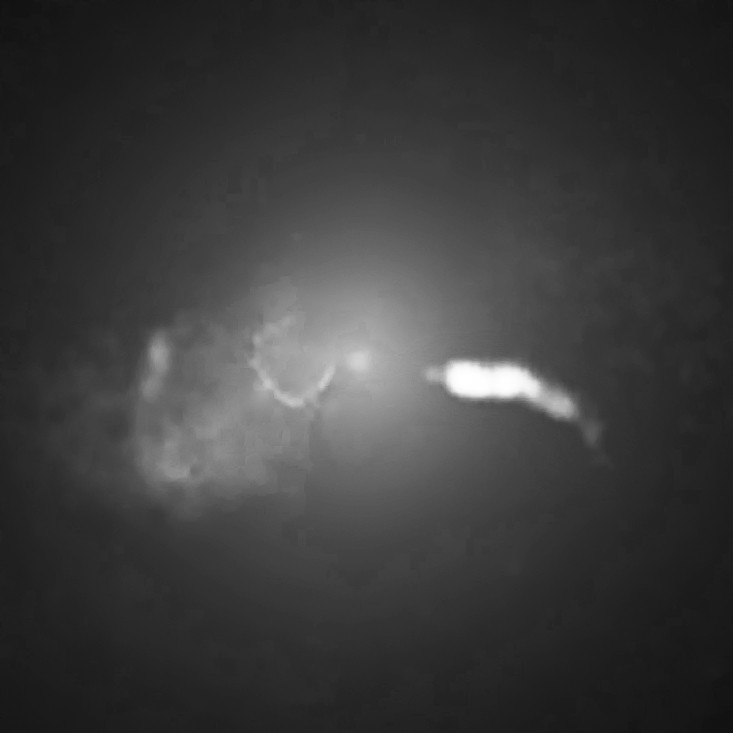 jac berne (flickr)
jac berne (flickr)
Re: APOD: The Galaxy, the Jet, and a Famous... (2023 May 04)
Posted: Thu May 04, 2023 12:48 pm
by VictorBorun
AVAO wrote: ↑Thu May 04, 2023 10:38 am
Another interesting detail of the SPITZER picture is the hidden "smoke" ring (blue channel) on the left. I'm pretty sure this isn't an imaging error and it will turn out that it wasn't accidental. Let's see when the next papers will appear on arxiv to that topic

 jac berne (flickr)
jac berne (flickr)
how come there is no trace of the IR smoke ring in radio
...
Re: APOD: The Galaxy, the Jet, and a Famous... (2023 May 04)
Posted: Thu May 04, 2023 2:48 pm
by Christian G.
There are some iconic astronomy pictures one might get tired of seeing over and over again, but M87* will never be one of them for me! I can't get enough of it. Just to fathom its size, I find this image useful, compared to the Milky Way smbh:
![Image]()
/Users/christian/Desktop/M87*-Sgr A* .png
(edit: I can't seem to figure out the most basic function of inserting an image here)
(edit 2:
https://blogs.futura-sciences.com/lumin ... tances.png) Thank you bystander.
Re: APOD: The Galaxy, the Jet, and a Famous... (2023 May 04)
Posted: Thu May 04, 2023 3:08 pm
by bystander
Chris Alex wrote: ↑Thu May 04, 2023 2:48 pm
There are some iconic astronomy pictures one might get tired of seeing over and over again, but M87* will never be one of them for me! I can't get enough of it. Just to fathom it's size, I find this image useful, compared to the Milky Way smbh:
![Image]()
/Users/christian/Desktop/M87*-Sgr A* .png
(edit: I can't seem to figure out the most basic function of inserting an image here)
How to post images
Re: APOD: The Galaxy, the Jet, and a Famous... (2023 May 04)
Posted: Thu May 04, 2023 3:28 pm
by VictorBorun
jac berne's Vanishing smoke ring between the invisible counter-jet and the hot arc it created
in radiowaves, too
...
Re: APOD: The Galaxy, the Jet, and a Famous... (2023 May 04)
Posted: Thu May 04, 2023 4:27 pm
by tyreecallahan@gmail.com
Quick question regarding this quote from the embedded link at the end, showing the new hi-res photo:
"The shadow of a black hole is the closest we can come to an image of the black hole itself, a completely dark object from which light cannot escape. In the case of Messier 87, the black hole’s boundary — the event horizon from which the EHT takes its name — is around 2.5 times smaller than the shadow it casts and measures just under 40 billion kilometers across."
Is the dark region inside the ring presumed to be the actual black hole, or is that region the aforementioned shadow, and the object itself is nestled somewhere inside the shadow? I'm having a hard time considering the 40-billion kilometer size against the jets, which are measured in thousands of light years.
Re: APOD: The Galaxy, the Jet, and a Famous... (2023 May 04)
Posted: Thu May 04, 2023 4:52 pm
by Christian G.
Isn't it fabulous that gamma-ray bursts and quasars are tied to black holes? The greatest source of light in the universe is found on the edge of darkness. Quite a cosmic symbol..
Re: APOD: The Galaxy, the Jet, and a Famous... (2023 May 04)
Posted: Thu May 04, 2023 7:39 pm
by AVAO
VictorBorun wrote: ↑Thu May 04, 2023 3:28 pm
jac berne's Vanishing smoke ring between the invisible counter-jet and the hot arc it created
in radiowaves, too
M87 2.jpgM87 2-.jpg
...
Cool. Exciting comparison.
The area surrounding the BH is also quite wild at Hubble - but no ring, that's right.
 https://live.staticflickr.com/65535/528 ... 7364_o.jpg
https://live.staticflickr.com/65535/528 ... 7364_o.jpg
jac berne (flickr)
Re: APOD: The Galaxy, the Jet, and a Famous... (2023 May 04)
Posted: Thu May 04, 2023 8:28 pm
by orin stepanek
I am glad we have an actual photo of a black hole! It brings reality
to what we are understanding about the universe!

Re: APOD: The Galaxy, the Jet, and a Famous... (2023 May 04)
Posted: Thu May 04, 2023 8:59 pm
by VictorBorun
radio, two lobes, the invisible counter-jet passes the smoking ring / visual light, no lobes, no smoking ring
...
Re: APOD: The Galaxy, the Jet, and a Famous... (2023 May 04)
Posted: Fri May 05, 2023 2:54 am
by Avalon
I've read so much about this not being an image of an actual black hole. So, is it, or is it not?
Re: APOD: The Galaxy, the Jet, and a Famous... (2023 May 04)
Posted: Fri May 05, 2023 4:22 am
by Ann
Avalon wrote: ↑Fri May 05, 2023 2:54 am
I've read so much about this not being an image of an actual black hole. So, is it, or is it not?
It is an actual black hole, but photographing it was very difficult. First, the galaxy hosting the black hole is far away, some 55 million light-years away. Then the black hole itself is small
ish - big compared with the Solar system, but very small when seen from a distance of 55 million light-years.
Moreover, the picture of the black hole is a radio image, taken by radio telescopes in radio waves. Radio telescopes over much of the world cooperated to create a "virtual telescope" that is as large as the Earth, but with gaps (because there are large patches of the world where there aren't any radio telescopes). It was like taking a picture of an object where, so to say, you don't have the full picture, and then trying to fill in the gaps.
Also, photographing a black hole isn't like photographing an object that emits light (like the Sun) or reflects light (like the Earth, and all the things on Earth). Black holes do neither. As I said, this is a radio image, showing radio emission surrounding the black hole (the bright ring, if I have understood things correctly). I believe that the black object in the center is "the shadow of the black hole". Don't ask me to explain.
So the picture is a real portrait of a black hole all right, but it is "a picture with limitations".
Ann
Re: APOD: The Galaxy, the Jet, and a Famous... (2023 May 04)
Posted: Fri May 05, 2023 8:36 am
by beryllium732
How would it be living in that galaxy? Would the nightsky be black with lots of stars but no galaxy disc in it with an expeption of a big jet sticking out in the nightsky?
Re: APOD: The Galaxy, the Jet, and a Famous... (2023 May 04)
Posted: Fri May 05, 2023 9:56 am
by VictorBorun
beryllium732 wrote: ↑Fri May 05, 2023 8:36 am
How would it be living in that galaxy? Would the nightsky be black with lots of stars but no galaxy disc in it with an expeption of a big jet sticking out in the nightsky?
add the boredom of red-and-dead star population: almost every star is a little smaller and yellower than Sun or is a red dwarf and not seen at all
Re: APOD: The Galaxy, the Jet, and a Famous... (2023 May 04)
Posted: Fri May 05, 2023 10:04 am
by beryllium732
VictorBorun wrote: ↑Fri May 05, 2023 9:56 am
beryllium732 wrote: ↑Fri May 05, 2023 8:36 am
How would it be living in that galaxy? Would the nightsky be black with lots of stars but no galaxy disc in it with an expeption of a big jet sticking out in the nightsky?
add the boredom of red-and-dead star population: almost every star is a little smaller and yellower than Sun or is a red dwarf and not seen at all
You are sure about that? Wouldn't there be a lot of Betelgeuses in the nightsky too except red dwarfs and more reddish yellow suns?
Re: APOD: The Galaxy, the Jet, and a Famous... (2023 May 04)
Posted: Fri May 05, 2023 12:23 pm
by Christian G.
I've read an astrophysicist specializing in black holes suggesting that the orange ring we see in the image is not the accretion disk but the photon sphere. Does that make any sense? Or change anything?
Re: APOD: The Galaxy, the Jet, and a Famous... (2023 May 04)
Posted: Fri May 05, 2023 4:48 pm
by VictorBorun
beryllium732 wrote: ↑Fri May 05, 2023 10:04 am
VictorBorun wrote: ↑Fri May 05, 2023 9:56 am
beryllium732 wrote: ↑Fri May 05, 2023 8:36 am
How would it be living in that galaxy? Would the nightsky be black with lots of stars but no galaxy disc in it with an expeption of a big jet sticking out in the nightsky?
add the boredom of red-and-dead star population: almost every star is a little smaller and yellower than Sun or is a red dwarf and not seen at all
You are sure about that? Wouldn't there be a lot of Betelgeuses in the nightsky too except red dwarfs and more reddish yellow suns?
Betelgeuse's … 15–20 M☉ … 70% hydrogen, 28% helium, and 2.4% heavy elements …
Rapidly-rotating 20 M☉ stars take 9.3 million years to reach the red supergiant stage,
while 20 M☉ stars with slow rotation take only 8.1 million years.
It's common for a Milky Way planet to see a 10 million years old star in the sky, but for an M87 planet?…
Re: APOD: The Galaxy, the Jet, and a Famous... (2023 May 04)
Posted: Fri May 05, 2023 5:21 pm
by Chris Peterson
beryllium732 wrote: ↑Fri May 05, 2023 8:36 am
How would it be living in that galaxy? Would the nightsky be black with lots of stars but no galaxy disc in it with an expeption of a big jet sticking out in the nightsky?
Their "Milky Way" would be a "Milky Blob" with the size and position depending on the location of the observer. The jet would not be visible.
Re: APOD: The Galaxy, the Jet, and a Famous... (2023 May 04)
Posted: Fri May 05, 2023 5:59 pm
by Ann
beryllium732 wrote: ↑Fri May 05, 2023 10:04 am
VictorBorun wrote: ↑Fri May 05, 2023 9:56 am
beryllium732 wrote: ↑Fri May 05, 2023 8:36 am
How would it be living in that galaxy? Would the nightsky be black with lots of stars but no galaxy disc in it with an expeption of a big jet sticking out in the nightsky?
add the boredom of red-and-dead star population: almost every star is a little smaller and yellower than Sun or is a red dwarf and not seen at all
You are sure about that? Wouldn't there be a lot of Betelgeuses in the nightsky too except red dwarfs and more reddish yellow suns?
There are no (or at least extremely few) Betelgueses in the skies of any putative planet inside M87.
Betelgeuse is a young massive star. Only massive stars can become red supergiants thousands of times brighter than the Sun, and such massive stars die young. And since M87 is absolutely overwhelmingly dominated by old stars, there will be no Betelgeuses among them.
Here is how you can tell old modest red giant stars from young brilliant red supergiants. First, let's look at some young red supergiants, which are typically surrounded by many bright blue stars:
The Double Cluster of Perseus. At least 5 and possibly 7 red supergiants stand out
among the blue stars. The clusters are believed to be some 12 million years old.
Image credit: Tommy Lease.
Old red stars keep a different company than the brilliant red supergiants with their entourage of blue stars:
Old open cluster Trumpler 5. This cluster is similar in age to the Sun.
Image: zirl.
Red supergiants are young massive stars, and they are typically surrounded by a large number of bright blue stars. Old red stars are much more modest, much less bright, don't stand out very much, and are not surrounded by blue stars (unless there happens to be one or more blue stragglers around).
Take a look at cluster NGC 2158. This cluster may be some 14,000 light-years away, and I found a Gaia parallax for the brightest red star which suggests that the V luminosity of this star is some ~68 times solar. That is not bad, but it is so very far from the brightness of a supergiant.
As for Trumpler 5, there is a star (at lower left) that stands out. However, this is a foreground star, at "only" some 3,400 light-years, whereas Trumpler 5 proper is at a distance of some 11,000 light-years. The V luminosity of the foreground star is some ~140 solar luminosities. That is not bad, but it is still in no way comparable to a supergiant.
By comparison, HD 14270, one of the red supergiants in the Double Cluster, has a V luminosity of some 3,100 solar. AS for BM Sco, the bright red non-supergiant, its V luminosity is some 1,000 solar.
Ann
Re: APOD: The Galaxy, the Jet, and a Famous... (2023 May 04)
Posted: Fri May 05, 2023 7:01 pm
by VictorBorun
Chris Peterson wrote: ↑Fri May 05, 2023 5:21 pm
beryllium732 wrote: ↑Fri May 05, 2023 8:36 am
How would it be living in that galaxy? Would the nightsky be black with lots of stars but no galaxy disc in it with an expeption of a big jet sticking out in the nightsky?
Their "Milky Way" would be a "Milky Blob" with the size and position depending on the location of the observer. The jet would not be visible.
But if a human on an Earth copy in M87 blocked the stars and let eyes adapt… still no jet?
But if the jet goes right their way and is 1000 times as bright as for Earth 1?
Re: APOD: The Galaxy, the Jet, and a Famous... (2023 May 04)
Posted: Fri May 05, 2023 7:06 pm
by Chris Peterson
VictorBorun wrote: ↑Fri May 05, 2023 7:01 pm
Chris Peterson wrote: ↑Fri May 05, 2023 5:21 pm
beryllium732 wrote: ↑Fri May 05, 2023 8:36 am
How would it be living in that galaxy? Would the nightsky be black with lots of stars but no galaxy disc in it with an expeption of a big jet sticking out in the nightsky?
Their "Milky Way" would be a "Milky Blob" with the size and position depending on the location of the observer. The jet would not be visible.
But if a human on an Earth copy in M87 blocked the stars and let eyes adapt… still no jet?
But if the jet goes right their way and is 1000 times as bright as for Earth 1?
M87 is easily seen in a telescope, but its jet is not visible. Neither getting closer nor magnification makes things brighter.
Re: APOD: The Galaxy, the Jet, and a Famous... (2023 May 04)
Posted: Fri May 05, 2023 7:45 pm
by AVAO
Ann wrote: ↑Fri May 05, 2023 4:22 am
Avalon wrote: ↑Fri May 05, 2023 2:54 am
I've read so much about this not being an image of an actual black hole. So, is it, or is it not?
It is an actual black hole, but photographing it was very difficult. First, the galaxy hosting the black hole is far away, some 55 million light-years away. Then the black hole itself is small
ish - big compared with the Solar system, but very small when seen from a distance of 55 million light-years.
Moreover, the picture of the black hole is a radio image, taken by radio telescopes in radio waves. Radio telescopes over much of the world cooperated to create a "virtual telescope" that is as large as the Earth, but with gaps (because there are large patches of the world where there aren't any radio telescopes). It was like taking a picture of an object where, so to say, you don't have the full picture, and then trying to fill in the gaps.
Also, photographing a black hole isn't like photographing an object that emits light (like the Sun) or reflects light (like the Earth, and all the things on Earth). Black holes do neither. As I said, this is a radio image, showing radio emission surrounding the black hole (the bright ring, if I have understood things correctly). I believe that the black object in the center is "the shadow of the black hole". Don't ask me to explain.
So the picture is a real portrait of a black hole all right, but it is "a picture with limitations".
Ann
"So the picture is a
real portrait of a black hole all right, but it is "a picture with limitations".
Well. In that case we would have to talk about what we mean by "real". In the paper below there are about 200 interpretation variants of the raw data and the indication that the interpretations were created by four competing teams.
Even if you have finally selected the statistically most likely of them, the question is whether you really want to refer to a statistically most likely interpretation of the data or not. Personally, I would be a little cautious about speaking of an "image" of the observed object.
Regardless of that, it doesn't really matter. It is important that once the algorithm has been defined, it is also applied identically to later observations in order to be able to observe changes and also derive new interpretations of the changes. Or if the same algorithm applied to other BH such as that of the Milky Way galaxy for comparison.
https://iopscience.iop.org/article/10.3 ... ab0e85/pdf
 The Galaxy, the Jet, and a Famous Black Hole
The Galaxy, the Jet, and a Famous Black Hole